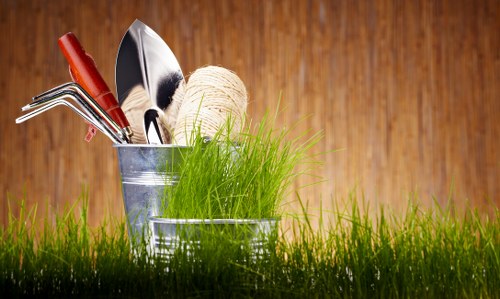Comprehensive Guide to Hedge Trimming in Uxbridge

Introduction to Hedge Trimming
Hedge trimming is an essential aspect of maintaining the aesthetic and health of your garden. In Uxbridge, with its diverse climate and variety of plant species, proper hedge maintenance ensures that your hedges remain lush, healthy, and visually appealing throughout the year.
Regular trimming not only enhances the appearance of your property but also promotes healthy growth by removing dead or diseased branches. Whether you're a homeowner looking to maintain your garden or a professional landscaper offering services in Uxbridge, understanding the fundamentals of hedge trimming is crucial.
In this article, we will delve into the various aspects of hedge trimming, including the best practices, tools required, timing, and the benefits it brings to your garden.

Benefits of Regular Hedge Trimming
1. Promotes Healthy Growth
Regular trimming removes dead or diseased branches, allowing the plant to direct its energy towards healthy growth. This results in denser and more vibrant hedges.
2. Enhances Curb Appeal
Well-maintained hedges significantly boost the visual appeal of your property. They create a neat and tidy appearance, adding value to your home.
3. Prevents Overgrowth
Without regular trimming, hedges can quickly become overgrown, making maintenance more challenging and potentially harming the plant’s health.

Types of Hedges Common in Uxbridge
Uxbridge homeowners often opt for a variety of hedge types, each offering unique benefits and requiring specific care routines.
- Boxwood Hedges: Known for their dense foliage and ability to be shaped precisely.
- Privet Hedges: Fast-growing and ideal for creating privacy screens.
- Laurel Hedges: Evergreen with large, glossy leaves, perfect for year-round greenery.
- Yew Hedges: Durable and long-lasting, suitable for intricate designs.

Essential Tools for Hedge Trimming
Having the right tools is paramount for effective hedge trimming. Here are the essential tools you need:
- Hedge Trimmers: Electric or gas-powered, these are ideal for large hedges.
- Pruning Shears: Perfect for precision trimming and shaping.
- Loppers: Used for cutting thicker branches that hedgehoggers can’t handle.
- Gloves: Protect your hands from thorns and debris.
- Ladders: For reaching higher sections of tall hedges safely.
Investing in high-quality tools not only makes the trimming process easier but also ensures cleaner cuts, promoting healthier plant growth.
Always ensure your tools are well-maintained and sharpened for optimal performance.

Best Practices for Hedge Trimming
Adhering to best practices ensures that your hedges remain healthy and vibrant. Here are some guidelines to follow:
1. Timing Your Trimming
The best time to trim hedges in Uxbridge is during late spring or early summer. This timing allows the plants to recover quickly and promotes robust new growth.
Avoid Trimming During Extreme Weather
Extreme heat or cold can stress the plants. Make sure to choose a mild day for trimming to minimize plant stress.
2. Understanding Plant Growth Patterns
Different hedge species have varying growth patterns. Understanding these patterns helps in making precise cuts that shape the hedge effectively without harming it.
3. Making the Right Cuts
Always make clean cuts at a slight angle to prevent water from pooling on the cut surface, which can lead to disease.
Use the three-cut method for thicker branches: first an undercut, then an overcut, and finally remove the branch completely. This prevents damage to the surrounding plants.
Remember: Avoid cutting too much at once. Trim gradually to maintain the hedge's natural shape.
Hiring Professional Hedge Trimming Services in Uxbridge
While DIY trimming can be cost-effective, hiring professionals offers several advantages:
- Expertise: Professionals have the knowledge and experience to handle different hedge types and challenges.
- Time-Saving: Trimming large or numerous hedges can be time-consuming. Professionals can complete the job efficiently.
- Proper Equipment: Access to high-quality tools ensures precise and clean cuts.
- Safety: Professionals are trained to handle equipment safely, reducing the risk of accidents.
When choosing a service, look for companies with good reviews, appropriate certifications, and a portfolio of previous work in Uxbridge.
Book your service now to keep your hedges in pristine condition.
Environmental Considerations
Hedge trimming not only benefits your garden but also has positive environmental impacts:
- Promotes Biodiversity: Healthy hedges provide habitats for various wildlife species.
- Air Quality Improvement: Lush hedges contribute to better air quality by absorbing pollutants.
- Carbon Sequestration: Green plants capture carbon dioxide, helping mitigate climate change.
By maintaining your hedges responsibly, you contribute to the local ecosystem's health and sustainability.
Eco-Friendly Trimming Practices
Adopt eco-friendly practices such as recycling trimmings, using organic fertilizers, and avoiding chemical pesticides to ensure your hedge trimming benefits the environment.
Common Mistakes to Avoid
Avoid these common mistakes to ensure effective hedge trimming:
- Over-Trimming: Cutting too much can stress the plant and inhibit growth.
- Wrong Timing: Trimming during the wrong season can harm the plant's development.
- Using Dull Tools: Dull blades cause jagged cuts, increasing the risk of disease.
- Ignoring Plant Health: Failing to address underlying health issues can lead to hedge decline.
- Improper Shaping: Shaping hedges too aggressively can distort their natural form.
By being mindful of these pitfalls, you can maintain healthy and attractive hedges.
Seasonal Hedge Trimming Tips
Different seasons require different trimming approaches:
- Spring: Focus on shaping and stimulating new growth.
- Summer: Maintain size and remove any dead or diseased branches.
- Autumn: Prepare hedges for winter by trimming lightly and ensuring they are not overcrowded.
- Winter: Minimal trimming is advisable to prevent damage from cold weather.
Adjust your trimming routine based on seasonal changes to keep your hedges healthy year-round.
Always consider the specific needs of your hedge type when planning seasonal trims.
Hedge Trimming Costs in Uxbridge
The cost of hedge trimming in Uxbridge varies based on several factors:
- Hedge Size: Larger hedges require more time and resources.
- Hedge Type: Some species are more labor-intensive to trim.
- Accessibility: Difficult-to-reach hedges may incur additional charges.
- Frequency: Regular maintenance contracts may offer discounted rates.
On average, homeowners can expect to pay between £50 to £150 per hedge, depending on the aforementioned factors.
It’s advisable to obtain multiple quotes from reputable services in Uxbridge to ensure competitive pricing.
Value for Money
Investing in quality hedge trimming services ensures that your hedges are well-maintained, enhancing your property’s value and curb appeal.
DIY Hedge Trimming Tips
If you prefer to trim your hedges yourself, here are some tips to ensure success:
- Plan Your Trim: Decide on the shape and size before starting.
- Use the Right Tools: Ensure all tools are sharp and in good condition.
- Work in Sections: Tackle one section at a time for precision.
- Step Back Frequently: Assess your progress to maintain symmetry.
- Clean Up: Remove all trimmings to prevent pest infestations.
Safety First: Wear protective gear and be cautious when using tools to prevent injuries.
With these tips, you can achieve professional-looking results even as a DIY enthusiast.
Benefits of DIY Trimming
Trimming your hedges yourself can be cost-effective and allows you to tailor the maintenance to your specific preferences.
Choosing the Right Hedge Trimming Service in Uxbridge
Selecting a reliable hedge trimming service is essential for achieving the best results. Consider the following when making your choice:
- Experience: Choose services with proven experience in hedge trimming.
- Reputation: Look for positive reviews and testimonials from previous clients.
- Insurance: Ensure the company is insured to cover any potential damages.
- Services Offered: Some companies offer additional services like garden maintenance or landscape design.
- Pricing: Compare quotes to find a service that fits your budget.
Taking the time to research and select the right service will save you time and ensure your hedges are maintained to the highest standard.
Contact us today to schedule a consultation with top-rated hedge trimming professionals in Uxbridge.
Maintaining Your Hedges Between Trims
Proper maintenance extends beyond regular trimming. Here are ways to keep your hedges healthy between trims:
1. Watering
Ensure your hedges receive adequate water, especially during dry spells. Deep watering encourages strong root growth.
2. Fertilizing
Apply organic fertilizers to provide essential nutrients, promoting vigorous growth and resilience against diseases.
3. Pest Control
Monitor for pests and treat infestations promptly to prevent damage to your hedges.
Pruning Dead Branches
Regularly inspect your hedges and remove any dead or damaged branches to maintain their health and appearance.
4. Mulching
Mulch around the base of your hedges to retain moisture, suppress weeds, and regulate soil temperature.
Consistent care ensures that your hedges remain attractive and healthy throughout the year.
Common Hedge Trimming Techniques
Different trimming techniques can achieve various aesthetic and functional goals:
- Formal Trimming: Creates symmetrical and geometric shapes, ideal for structured garden designs.
- Informal Trimming: Maintains the natural shape and form of the hedge, offering a more relaxed appearance.
- Shearing: Uses hedge trimmers to achieve a uniform surface, commonly used for busy hedges.
- Cut and Shape: Involves selective cutting to shape the hedge without full shearing.
Choosing the right technique depends on the desired look and the specific characteristics of your hedge.
Topiary
Topiary involves shaping hedges into decorative forms, such as animals or geometric shapes. This technique requires patience and skill but can add a unique touch to your garden.
Legal Considerations in Uxbridge
When trimming hedges, it’s important to be aware of local regulations and property boundaries:
- Boundary Lines: Ensure you are trimming your own hedges and not encroaching on neighbors' properties.
- Height Restrictions: Some areas have restrictions on the maximum height of hedges, especially near roads or public spaces.
- Protected Species: Certain hedge species may be protected, requiring special permits for trimming.
- Local Ordinances: Check for any specific local rules regarding garden maintenance and hedge trimming.
Adhering to these regulations helps maintain good relations with neighbors and avoids potential legal issues.
Dispute Resolution
If disputes arise over hedge boundaries, seek mediation or consult local authorities to resolve the matter amicably.
Innovations in Hedge Trimming
Advancements in technology have revolutionized hedge trimming, making the process more efficient and precise:
- Battery-Powered Trimmers: Offer portability and reduced noise compared to traditional gas-powered trimmers.
- Robotic Hedge Trimmers: Automate the trimming process, ideal for large properties.
- Advanced Blades: Enhanced blade designs improve cutting efficiency and reduce plant stress.
- Smart Tools: Integrated with sensors and connectivity features to monitor trimming needs and maintenance schedules.
Embracing these innovations can enhance the effectiveness of your hedge trimming routine.
Eco-Friendly Solutions
Modern trimming tools are increasingly eco-friendly, reducing emissions and energy consumption while delivering superior performance.
Case Studies: Successful Hedge Trimming in Uxbridge
Examining successful hedge trimming projects can provide valuable insights:
Residential Garden Makeover
One Uxbridge resident transformed their overgrown hedges into beautifully shaped privacy screens, enhancing both privacy and curb appeal.
Commercial Property Enhancement
A local business invested in professional hedge trimming services to create an inviting entrance, boosting customer impressions and brand image.
Community Park Maintenance
The maintenance of hedges in Uxbridge’s community parks ensures well-kept green spaces that residents enjoy year-round.
These case studies highlight the transformative impact of proper hedge trimming.
Frequently Asked Questions
How often should I trim my hedges?
Generally, hedges should be trimmed 2-3 times a year. However, the frequency depends on the hedge type and growth rate.
Can I trim my hedges myself?
Yes, with the right tools and knowledge, DIY trimming is feasible. However, for large or complex hedges, professional services are recommended.
What are the signs that my hedges need trimming?
Signs include overgrowth, uneven shape, dead or diseased branches, and reduced plant health.
Is hedge trimming bad for the environment?
No, when done responsibly, hedge trimming promotes plant health and supports local ecosystems.
What is the best time of year to trim hedges in Uxbridge?
Late spring to early summer is ideal, allowing plants to recover quickly and encouraging new growth.
If you have more questions or need expert assistance, contact us today for professional hedge trimming services in Uxbridge.
Get In Touch With Us.
Please fill out the form below to send us an email and we will get back to you as soon as possible.

